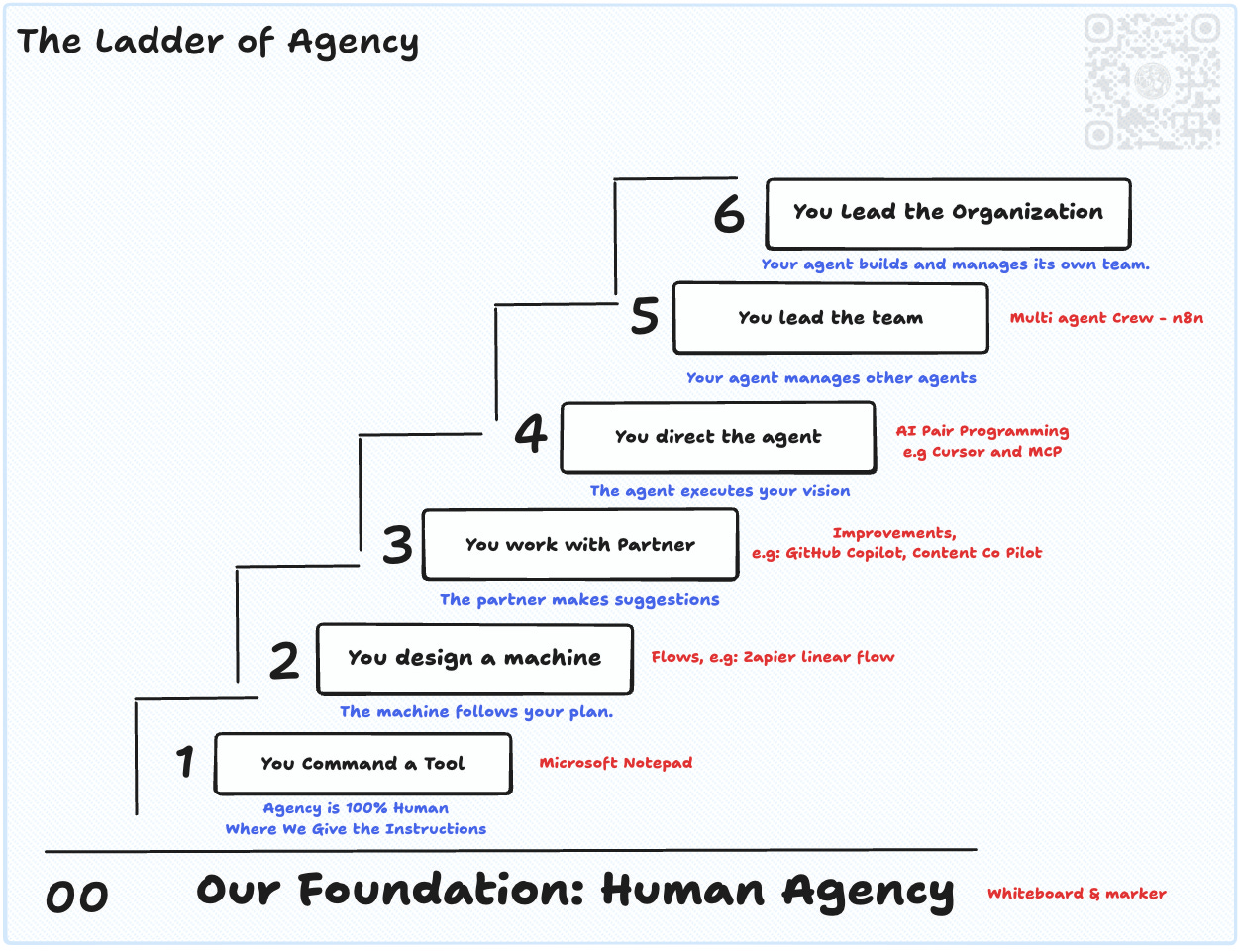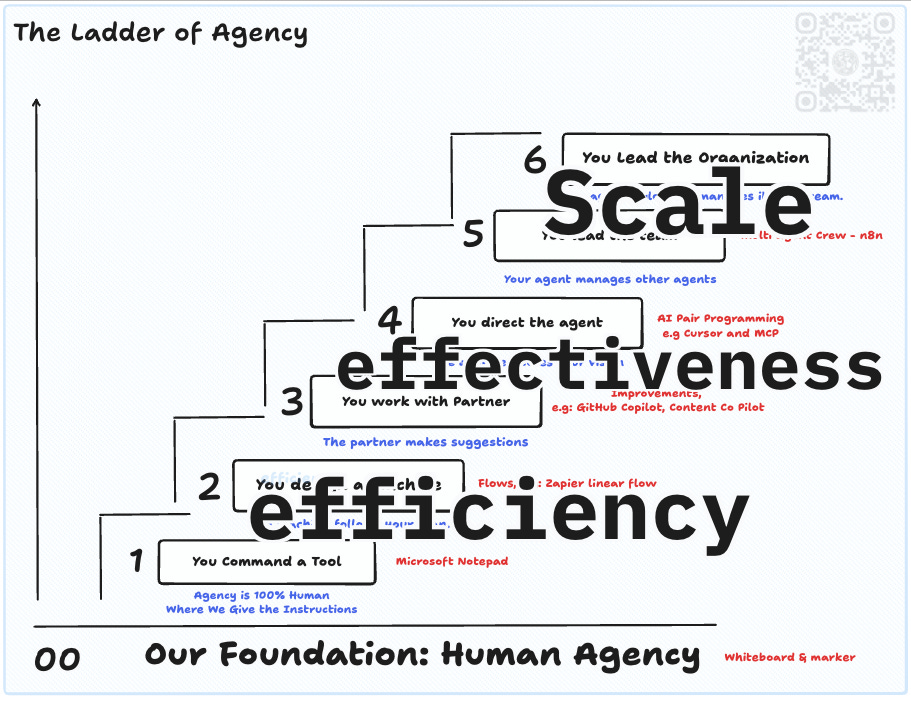How to Stop Chasing AI Tools and Start Building Real Leverage
Stop collecting tools and start climbing the Ladder of Agency. That is the essential business of AI!
They tell you you’re behind on AI. You see the demos, the endless stream of new tools, the breathless LinkedIn posts, and a knot forms in your stomach.
You’re a product builder/founder, you’re supposed to be on the cutting edge, but the AI landscape feels like a chaotic, deafening storm. The pressure to just “do something” is immense.
So you grab at tools. You try a chatbot here, an automation there. You’re busy, but you’re not making progress. The tools feel disconnected, brittle, and you’re still the one doing all the real thinking. This is the trap we’re seeing around.
Let's change the frame. The question isn't about tools. It's about AGENCY.
The Core Metaphor: A Ladder of Agency
Agency is the power to decide and do.
Instead of thinking about AI as a pile of features, think of it as a ladder of escalating agency. Each rung represents a fundamental shift in your relationship with technology, moving from giving instructions to delegating outcomes.
Your job as a product thinker/founder is to choose the right rung for the right job.
Rungs 1-2: The Mechanic
You Command a Tool, You Design a Machine
This is where most of the business world lives. You're using AI like a better version of Microsoft Notepad (Rung 1) or a more complex set of rules in an automation tool like “Zapier - back in the days without AI Agents 🤖” (Rung 2). You define the plan, and the machine executes your instructions.
The Trap: Believing this is the end game. You get stuck building ever-more-complex Rube Goldberg machines of linear automations. You’re saving time on tasks, but you haven't created any new leverage.
You're working in the system, not on it.Your Job: Master repeatable systems. Use linear flows for predictable work like lead nurturing, data entry, or report generation.
» The goal here is efficiency. Nail this for processes that don’t require judgment.
Rungs 3-4: The Conductor
You Work with a Partner, You Direct an Agent
This is the leap. You stop giving step-by-step instructions and start providing intent. You treat the AI as a partner that makes suggestions (GitHub Copilot, Rung 3) or an agent that executes your vision (Cursor, Rung 4). You delegate the "how."
The Trap: Micromanagement. You try to control every step the agent takes, strangling its potential. You don't give it a clear enough vision, so it produces generic, useless output. You treat your agent like a machine instead of a teammate.
Your Job: Learn to delegate with vision. Provide clear goals, context, and constraints. Your prompt isn't a command; it's a creative brief.
» The goal here is effectiveness. Use this for complex tasks that require creativity and judgment, like drafting a marketing strategy or coding a new feature.
Rungs 5-6: The Architect
You Lead a Team, You Lead an Organization
This is the frontier. You're no longer directing a single agent; you are leading a team of them (Rung 5). You set the mission, and your agents collaborate to achieve it, even building and managing their own teams (Rung 6).
The Trap: Fear of losing control. The system becomes a black box you don't understand. You haven't defined the organization's "Vibe," so the agents operate without principles, creating chaos.
Your Job: Set the constitution. You need to build a "Vibe Stack" → the combination of your company’s principles (Vibe), its agentic workflows (Flows), and the underlying models (Coding). This stack becomes the operating system for your autonomous organization.
» The goal here is scale, by building entirely new, self-managed business functions.
Linear vs. Agentic: The Right Flow for the Job
Your business has two kinds of problems: 1) predictable and 2) unpredictable. Using the wrong kind of AI flow is like using a hammer to turn a screw.
Use Linear Flows (Rungs 1-2) for Predictable Problems: When you have a defined process where the steps don't change, automate it. Think invoicing, employee onboarding, or data backups. The ROI is saving time and money.
Use Agentic Flows (Rungs 3-6) for Unpredictable Problems: When you have a goal but the path is unclear, deploy an agent. Think exploring a new market, designing a product, or running a competitive analysis. The ROI is speed of innovation and quality of decisions.
Product Builders →Remember the Round Story
When an investor asks for your AI strategy, don't list tools. Give them your framework.
"We don't chase AI tools; we deliberately choose our level of agency. For our operational processes like finance and support, we run at Rungs 1 and 2, using linear automation to be ruthlessly efficient. But for our core product development and market expansion → the work that requires real innovation, we operate at Rung 4. We deploy agents with a clear vision to explore, build, and learn faster than any of our competitors who are still just commanding tools. This allows us to scale our creativity, not just our tasks."
A Real Test For You
Stop what you're doing. Pick one “just one” recurring process in your organisation, vertical or startup.
Identify what rung of the Ladder of Agency it lives on today.
Ask yourself: What would it look like to move it up one rung? Not to full autonomy, just one step up.
Write down the first, smallest action you can take to make that happen this week.
The future of your business isn't about buying more AI tools. It's about leveling up your agency.
Follow up read.
If you're not deep in the technical waves and feel lost in the sea of AI terminology, the collection below is a powerful starting point. It cuts through the noise.
A great collection by Elena Calvillo.




